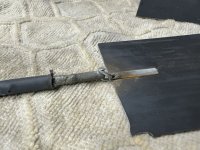Like a lot of folks here, I am seeing the dreaded 125/194 codes again now on my system for the third time since the pool was built. We are now just at the end of the 4th season on this pool and we are on our 3rd SWG cell that is now dying. I've had both replacements put in as warranty replacements by the PB, but I think I am on my own now. This last one lasted almost exactly 1 year, which I think is abnormally short. Examining the SWG cell and taking it apart, I found that the center post is completely corroded through (disconnected) at the point where it connects to the center plate. I have never cleaned the cell with acid nor does it have any deposits on it at all. It looks completely clean, like new except for that center post.
Why is it corroding so fast? I have had to SLAM the pool twice this season, but other than that the chemistry has been within TFP guidelines the whole time (only CYA is a little lower but my SWG duty cycle peaks at 40% mid-summer to maintain FC so I think that is good enough). CYA has been around 40-50, the FC around 3-4, I let the pH rise to about 7.9-8.0 before adjusting back down to 7.6 with acid, TA is 50-60 and CH 125-150. Last fall the CSI was just below zero (but pH was high at that time at 8.0 to 8.1), over the winter it dropped to -0.7 to -0.9, but the SWG is only at 10% (or off when water is below 50F). In the spring and over the summer, the CSI has been around -0.6 to -0.7.
Does anything in the chemistry look like it could be conducive to the posts corroding so bad?
Now to my repairs: I tried to solder the post to the plate, but that didn't work, I guess the metals are just not compatible with soldering. I then tried brazing with a copper brazing rod (used for HVAC copper tubing). That didn't want to flow and stick either.
Next, I drilled small holes in the rod and in the top of the plate and reconnected the post to the plate with a short copper wire then wrapped the wire and the connection to the post in waterproof gorilla tape. This worked and it was drawing 6.8A again and produced a lot of hydrogen bubbles. But it only last about 1.5 days before the codes were back again. Taking the cell apart, I found that the complete copper wire was gone (dissolved I suppose) with only a small stub left in the post.
Next, I used a steel nail to make the connection and wrapped the whole rod, connection to the nail, and the connection to the plate completely in gorilla tape to waterproof the whole thing. It's been in the pool for about 12 hours now and still working *knock on wood*.
Has anybody else tried repairing these? It seems crazy to throw away an $600 part only because one connection comes loose!!
Thanks!
Sam
Why is it corroding so fast? I have had to SLAM the pool twice this season, but other than that the chemistry has been within TFP guidelines the whole time (only CYA is a little lower but my SWG duty cycle peaks at 40% mid-summer to maintain FC so I think that is good enough). CYA has been around 40-50, the FC around 3-4, I let the pH rise to about 7.9-8.0 before adjusting back down to 7.6 with acid, TA is 50-60 and CH 125-150. Last fall the CSI was just below zero (but pH was high at that time at 8.0 to 8.1), over the winter it dropped to -0.7 to -0.9, but the SWG is only at 10% (or off when water is below 50F). In the spring and over the summer, the CSI has been around -0.6 to -0.7.
Does anything in the chemistry look like it could be conducive to the posts corroding so bad?
Now to my repairs: I tried to solder the post to the plate, but that didn't work, I guess the metals are just not compatible with soldering. I then tried brazing with a copper brazing rod (used for HVAC copper tubing). That didn't want to flow and stick either.
Next, I drilled small holes in the rod and in the top of the plate and reconnected the post to the plate with a short copper wire then wrapped the wire and the connection to the post in waterproof gorilla tape. This worked and it was drawing 6.8A again and produced a lot of hydrogen bubbles. But it only last about 1.5 days before the codes were back again. Taking the cell apart, I found that the complete copper wire was gone (dissolved I suppose) with only a small stub left in the post.
Next, I used a steel nail to make the connection and wrapped the whole rod, connection to the nail, and the connection to the plate completely in gorilla tape to waterproof the whole thing. It's been in the pool for about 12 hours now and still working *knock on wood*.
Has anybody else tried repairing these? It seems crazy to throw away an $600 part only because one connection comes loose!!
Thanks!
Sam










